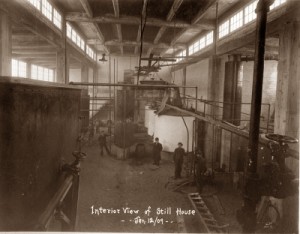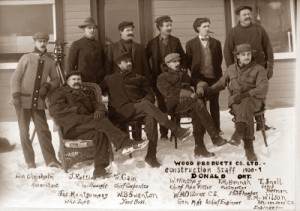 An Architectural Marvel
An Architectural Marvel
Called the “Chemical” by local residents, the Donald Chemical Distribution Building is the last remaining in-tact building of the Standard Chemical Company in Canada. Commissioned by Richard A. Donald the chemical plant was built in 1908 for a sum of $1M. The reinforced concrete building is architecturally unique and an engineering marvel. It is the first building in Canada to use chain reinforcement for roofing; it boasted the first concrete raised water tower in North America; has notable features of high tensile steel from Oneida in its columns; flint limestone brick from Fenelon falls used in the infill; highly dense concrete made from sand on-site; and displays a unique gable roof. Only three other industrial concrete buildings of this era exist in Ontario. The building is also markedly unique in a primarily natural landscape.
View PDF: A Notable Industrial Plant of Reinforced Concrete – University of Michigan – 1909
 Iron to Wood
Iron to Wood
In the early 1900s Canada was the largest importer of iron from England, and considered a poor country. It was thought that if iron was produced locally, Canada would become an economic power. Located close to the timber resources, the Donald Plant was the largest industrial iron coke producing plant in Ontario, exporting its products through rail and water across North America. However, in 1914 Canada become a major exporter of iron and the market collapsed. The plant was then sold for $1 to Wood Chemical Inc., who sold it to Standard Chemical Company lead by Mr. Peuchen a Titanic survivor and hero. The plant was then used to produce wood acetate for chemical applications and ammunitions.
 Impact
Impact
The “Chemical” changed the way we do business across central Ontario. It impacted the economic, social and ecological conditions across the region. The “Chemical” introduced wage labour where previously only barter systems existed, allowing for the import of new products, the making of new businesses and then changing relationships throughout the Highlands. Steam-generated hydro power was made by the plant 40 years before the electric companies arrived. The first markets and commercial stores were opened. The first cars bought and sold by employees. Immigrants of German and Italian descent were sought for their expertise in timbering and smelting. New traditions arose. The cultural fabric of the landscape was enriched.
Fostering Families
As relationships changed and newcomers arose, the Chemical became the fabric of local family history.
